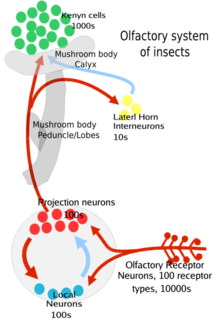
Insect olfaction refers to the function of chemical receptors that enable insects to detect and identify volatile compounds for foraging, predator avoidance, finding mating partners (via pheromones) and locating oviposition habitats.[1] Thus, it is the most important sensation for insects.[1] Most important insect behaviors must be timed perfectly which is dependent on what they smell and when they smell it.[2] For example, olfaction is essential for locating host plants and hunting prey in many species of insects, such as the moth Deilephila elpenor and the wasp Polybia sericea, respectively.
The two organs insects primarily use for detecting odors are the antennae and specialized mouth parts called the maxillary palps.[3] However, a recent study has demonstrated the olfactory role of ovipositor in fig wasps.[4] Inside of these olfactory organs there are neurons called olfactory receptor neurons which, as the name implies, house receptors for scent molecules in their cell membrane. The majority of olfactory receptor neurons typically reside in the antenna. These neurons can be very abundant; for example, Drosophila flies have 2,600 olfactory sensory neurons.[3]
Insects are capable of smelling and differentiating between thousands of volatile compounds both sensitively and selectively.[1][5] Sensitivity is how attuned the insect is to very small amounts of an odorant or small changes in the concentration of an odorant. Selectivity refers to the insects ability to tell one odorant apart from another. Among blood-feeding arthropods, these compounds are commonly broken into three classes: short chain carboxylic acids, aldehydes and low molecular weight nitrogenous compounds.[5]
Insects have been used as a model system to study mammal and especially human olfaction. Yet, unlike vertebrates who use G protein coupled receptors (GPCRs), insects express proteins including ORs (olfactory receptors), GRs (gustatory receptors) and IRs (ionotropic receptors) which are all heteromeric ligand-gated ion channels.[3] A moth species in the order of Lepidoptera known as the black cutworm moth (Agrotis ipsilon) produces even more proteins including OBPs (odorant-binding proteins), CSPs (chemosensory binding proteins), and SNMPs (sensory neuron membrane proteins) that help the moth recognize sex pheromones and odorants such as those released from host plants.[6] Much like in vertebrates, axons from the sensory neurons converge into glomeruli, but differ in where the glomeruli are housed. In mammals they are located in the olfactory bulbs, but in insects they are in the antennal lobe.[7]
- ^ a b c Carraher, Colm; Dalziel, Julie; Jordan, Melissa D.; Christie, David L.; Newcomb, Richard D.; Kralicek, Andrew V. (2015). "Towards an understanding of the structural basis for insect olfaction by odorant receptors". Insect Biochemistry and Molecular Biology. 66: 31–41. doi:10.1016/j.ibmb.2015.09.010. PMID 26416146.
- ^ Gadenne, Christophe; Barrozo, Romina B.; Anton, Sylvia (2016). "Plasticity in Insect Olfaction: To Smell or Not to Smell?". Annual Review of Entomology. 61: 317–333. doi:10.1146/annurev-ento-010715-023523. hdl:11336/19586. PMID 26982441.
- ^ a b c Li, Qian; Liberles, Stephen D. (2015). "Aversion and Attraction through Olfaction". Current Biology. 25 (3): R120–R1209. doi:10.1016/j.cub.2014.11.044. PMC 4317791. PMID 25649823.
- ^ Yadav, Pratibha; Borges, Renee M. (2017). "The insect ovipositor as a volatile sensor within a closed microcosm". Journal of Experimental Biology. 220 (9): 1554–1557. doi:10.1242/jeb.152777. PMID 28468812.
- ^ a b Syed, Zainulabeuddin (2015). "Chemical ecology and olfaction in arthropod vectors of diseases". Current Opinion in Insect Science. 10: 83–89. doi:10.1016/j.cois.2015.04.011. PMID 29588018.
- ^ Gu, Shao-Hua; et al. (2014). "Molecular Characterization and Differential Expression of Olfactory Genes in the Antennae of the Black Cutworm Moth Agrotis ipsilon". PLOS ONE. 9 (8): e103420. Bibcode:2014PLoSO...9j3420G. doi:10.1371/journal.pone.0103420. PMC 4118888. PMID 25083706.
- ^ Wilson, Rachel (2013). "Early olfactory processing in Drosophila: mechanisms and principles". Annual Review of Neuroscience. 36: 217–241. doi:10.1146/annurev-neuro-062111-150533. PMC 3933953. PMID 23841839.
© MMXXIII Rich X Search. We shall prevail. All rights reserved. Rich X Search
